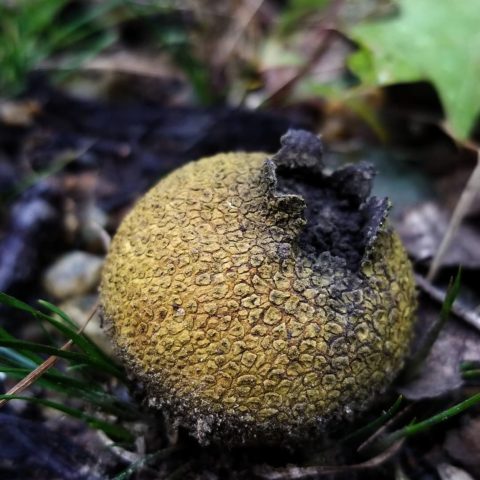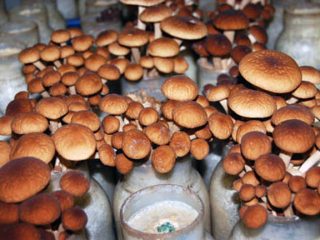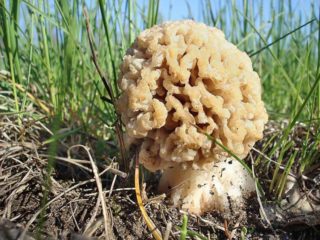Content
The common puffball is a gasterocymet fungus. This is one of the few representatives of this taxon that is not recommended for consumption. It got its name for its similarity to edible puffball mushrooms. Widely distributed throughout Russia. It is practically not used in cooking, but its medicinal properties are used in folk medicine.
What do common puffballs look like?
The fruiting body of the common puffball is difficult to confuse with any other species.It has a round or tuberous shape. Sometimes pear-shaped specimens are found. The diameter of the “tuber” can reach 5-6 cm. Near the ground itself, the body quickly narrows and a small bundle of mycelial fibers sticks out of it. The mushroom has a shell up to 4 mm thick.
Over the entire surface area, the common puffball is covered with a characteristic scaly shell of a dark yellow or brown hue. The color of the “scales” is darker, so it seems that there is a layer of dirt on the fruiting bodies. Sometimes they can be concentrated in the apex area, and its sides are almost smooth.
In some cases, the lower part of the common puffball is wrinkled. The upper part of the fruit body has thickenings in the form of warts, which often crack. In young mushrooms, the cracks quickly heal, but the body takes on a characteristic appearance.
The pulp of the common puffball is white when young. The ripening time of fruiting bodies occurs from the beginning of August to the end of September. During the ripening process, the color of the pulp changes. At first it turns purple-black. At this stage, thin white fibers can be distinguished inside it.
In older specimens, its color becomes brown and its consistency is powdery. The smell of the pulp in this state is reminiscent of raw potatoes. The finally ripe common puffball bursts in the “top” area. At the same time, its spores are scattered.
The spores of the common puffball are spherical and have spines on their surface. Their color is black-brown. Spore size is from 7 to 15 microns.
The mushroom has several doubles. One of them is the spotted puffball. It has a predominantly pear-shaped body, often lying on its side.Unlike the ordinary variety, this subspecies is smaller in size (1-5 cm) and has a less thick shell. Usually, it does not exceed 1 mm in thickness.
Another difference is the color and appearance of the skin. The color of the spotted subspecies is predominantly light yellow, and the scales cover the surface more evenly.
Another variety is called verrucous false puffball. It is somewhat larger than the spotted one, but still a little smaller in size than the common one. The diameter of its fruiting body is 2-5 cm.
Its surface is covered by a relatively hard, cork-like shell. The pulp at all stages of fruiting body formation is hard. Because of this, young mushrooms are inedible, although they have a pleasant taste and smell.
Similar to the common variety of false puffball, the flesh of the puffball often cracks. Color – brown or light brown.
Where do common puffballs grow?
This type of raincoat is very widespread. Like most representatives of its kingdom, it prefers temperate climate zones, where it is found even in the north up to 70 latitude. The huge range of the fungus covers almost all of Eurasia - from Western Europe to the Far East. Large colonies of mushrooms can be found in the Caucasus.
Common puffball grows in both coniferous and deciduous forests. Loves sunny areas. Most often found along forest edges and along roads. In humid forests it is adjacent to moss. It enters mycorrhizae mainly with hardwood trees of various species.
Is it possible to eat common puffballs?
False puffballs are inedible mushrooms, but they can be eaten in small quantities. They are used as a seasoning for meat dishes. Usually a few cloves of mushroom are added to the meat to give the food a slight truffle aroma.
It is recommended to use mushrooms while their flesh is white. Fruiting bodies do not require too much processing. Usually you just need to rinse the puffballs, peel them and fry them in a pan for a few minutes.
Medicinal properties
The fruiting bodies of mushrooms contain many bioactive components. Among them are:
- dimethylphenylalanine;
- palmitic and oleic fatty acids;
- ergosterol peroxide.
Also, the pulp of the false puffball, in addition to a large number of protein compounds, contains fumaric acid and calvacin. The latter is a natural anti-blastic agent that has been successfully used to inhibit the growth of cancer cells. Modern studies have shown a reduction in the size of malignant tumors in animals with cancer and sarcoma, which were administered drugs based on calvacin.
In folk medicine, the medicinal properties of fruiting bodies are used in the treatment and prevention of:
- oncological diseases;
- inflammatory processes;
- swelling of soft tissues;
- skin diseases (including psoriasis).
One of the uses of the body of the common puffball is to stop bleeding. The active substances contained in the false raincoat cope especially well with capillary bleeding.
Mostly in folk medicine of China and Russia, fresh mushrooms with white flesh are used externally. Sometimes a decoction is used for oral administration.
Conclusion
Common puffball is an inedible mushroom that grows in both deciduous and coniferous forests of temperate climates. The round balls of the fruiting bodies of this mushroom can be easily confused with its counterparts, which have slight differences. This mushroom has a highly specialized culinary use as a spice that adds a truffle aroma to meat dishes. In folk medicine, false puffball is used for the prevention and treatment of skin diseases, inflammation and some types of oncology.

















